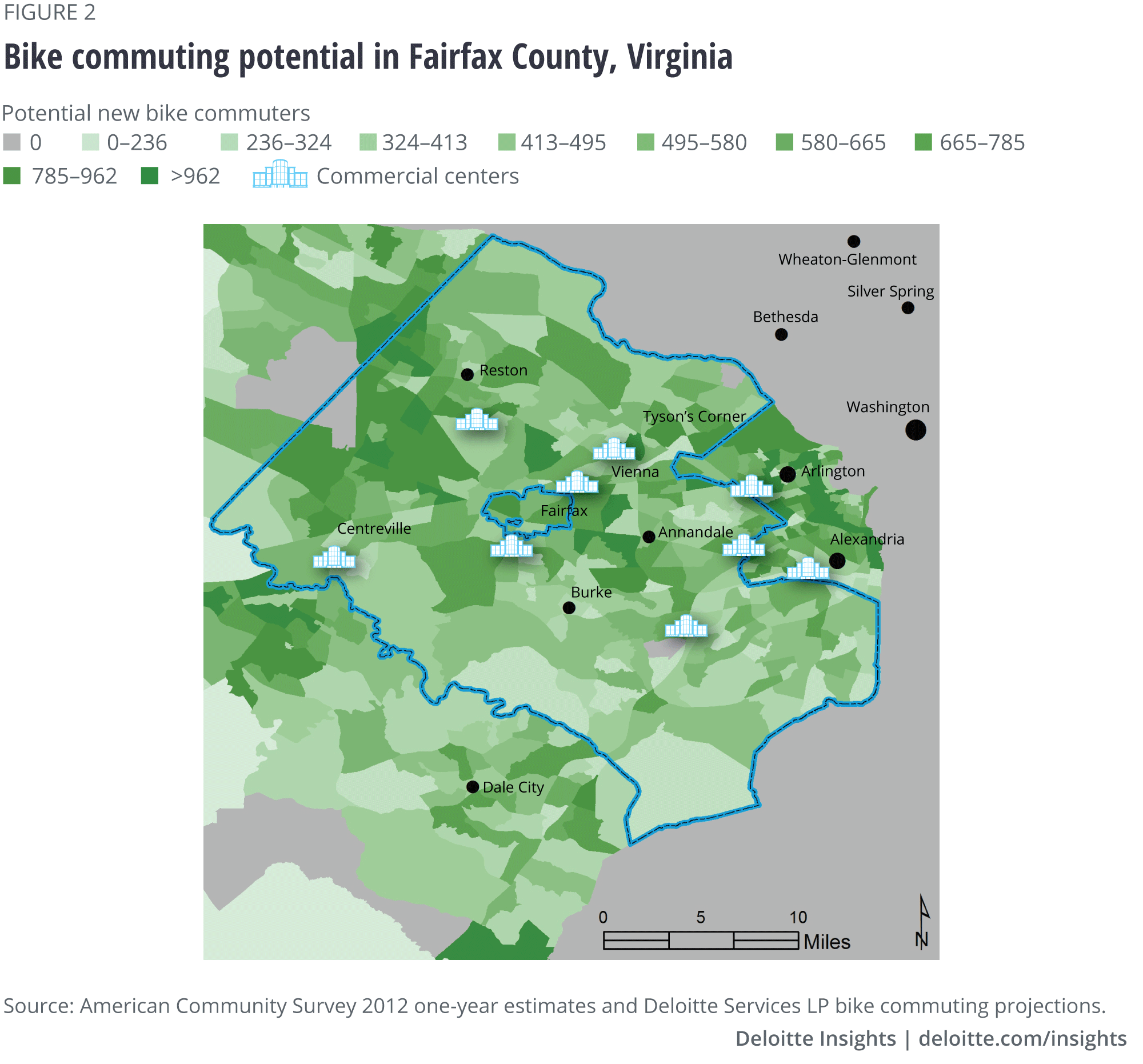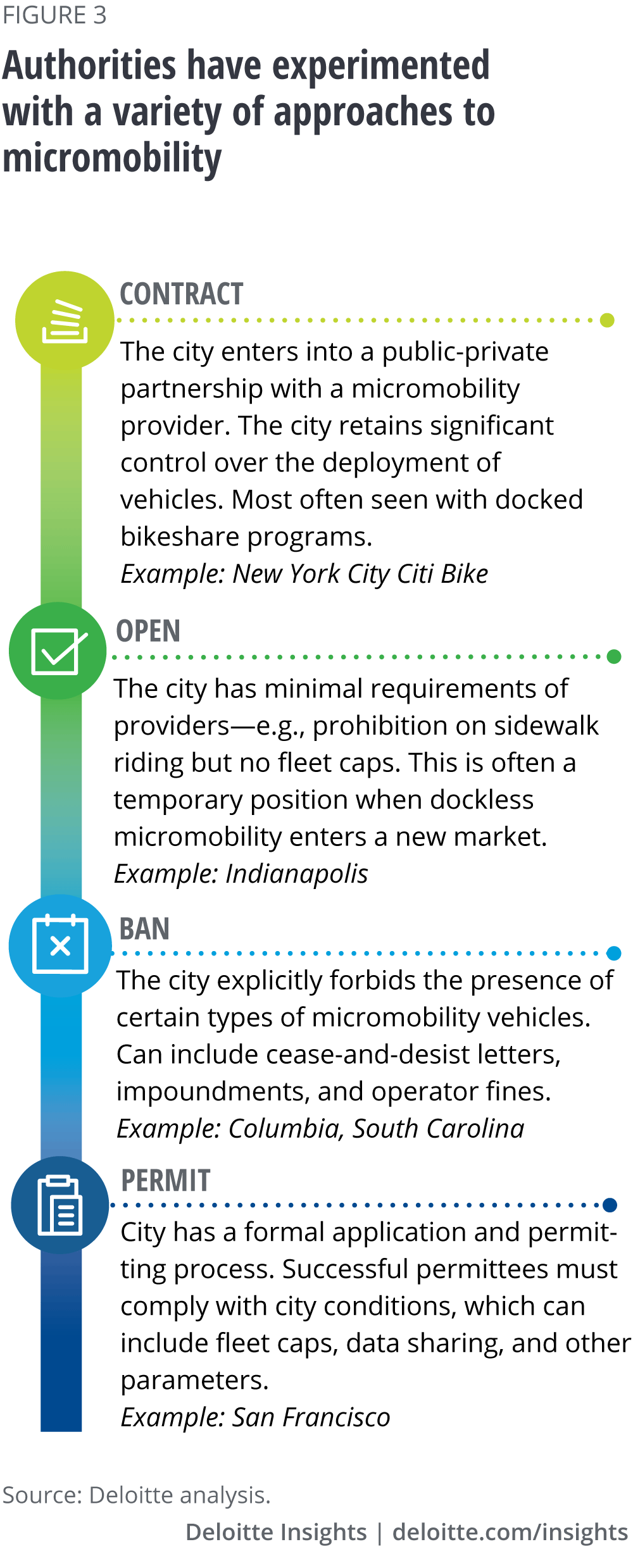
Small is beautiful Making micromobility work for citizens, cities, and service providers
17 minute read
16 April 2019
E-scooters and dockless bicycles appeared in cities’ bike lanes suddenly and in great numbers, showing a real demand for single-occupant vehicles—and creating challenges for both providers and government agencies.
In his 1973 essay collection Small Is Beautiful, economist E.F. Schumacher challenged economic orthodoxy, positing that “[t]oday, we suffer from an almost universal idolatry of gigantism. It is therefore necessary to insist on the virtues of smallness—where this applies.”1
Learn More
Explore the Future of mobility collection
Visit the Automotive collection
Subscribe to receive related content
Four and a half decades later, a fast-growing set of services are challenging “gigantism” in transportation—in the form of personal, often single-occupant cars—and championing the virtues of smallness. Electric scooters, docked and dockless shared bikes, and other vehicle types are shrinking the physical footprint needed to move people over relatively short distances.
Collectively dubbed micromobility, these services have clearly resonated with consumers, as evinced by their rapid adoption over just the last several months. They have the potential to better connect people with public transit, reduce reliance on private cars, and make the most of existing space by “right-sizing” the vehicle, all while reducing greenhouse gas emissions (although the picture is somewhat clouded by the need to use conventional vans or trucks to collect, charge, and reallocate e-scooters and e-bikes should be accounted for).2
Yet like any new entrants into a well-established system, many of these services have faced resistance, backlash, and growing pains, as seen most visibly in the sometimes-rocky relationship between city governments and e-scooter providers.3 In this article, we explore the evolution of the micromobility market and offer a glimpse into where it may be going. And we suggest practices for micromobility providers and government agencies eager to find a productive path forward.
Micromobility: Where it’s come from and where it’s going
Multiple criteria can be applied to define micromobility: weight (less than 500 kg),4 passenger or payload capacity, powertrain (human-powered or electric), maximum speeds or ranges, and others. Possibly the most fruitful way to think about what micromobility is and can be is in relation to existing infrastructure: Micromobility constitutes forms of transport that can occupy space alongside bicycles. That can mean dedicated bike lanes, along with roadside areas that are the de facto or de jure areas where bicyclists travel. Conversely, consider what micromobility isn’t. It is unsuitable for sidewalks, which are the domain of pedestrians and certain very-low-speed vehicles. And it is unsuitable for vehicle-occupied roads dominated by cars and trucks capable of highway speeds. (Predictably, some have used micromobility modes in both of these spaces, resulting in conflicts with other users.) In short, micromobility leverages bike space in ways that were not originally intended, and it is within this slice of public infrastructure that we expect much of the innovation in the industry to occur.
Practically, in most markets today, micromobility means shared scooters and bikes (both human-powered and those with electric motors, docked and dockless). That said, our conversations with industry leaders have made it clear that we are only scratching the surface with what is possible in terms of vehicle shape, size, and capability; we expect to see a variety of new designs emerging in the near future that stretch the definition of what might be considered micromobility.
Micromobility vehicles have a long history, going back at least two centuries from the invention of the bicycle through to the Razor kick scooter of the 1990s and, more recently, a variety of personally owned vehicles powered by small electric motors, ranging from hoverboards to scooters to skateboards, all with between one and four wheels. But it is only in the last few years that these modes have emerged as a true potential solution for urban mobility, enabled by advances in GPS tracking, connectivity, mobile payments, battery cost and longevity, and the growing ubiquity of smartphones.
Electric scooter services, in particular, have stormed from city to city since their commercial launches less than two years ago. Adoption rates during their short time on the market have been impressive, surpassing that seen by popular ride-hailing applications during their early days.5 Bird hit 10 million scooter rides within 12 months of first appearing on Southern California streets and sidewalks,6 while Lime users took 34 million trips across the company’s platform of vehicles—including e-scooters, electric and pedal-assist bikes, and carsharing—in that company’s first year.7 Others have moved quickly into this space, with major ride-hailing providers and automakers investing in the micromobility spectrum.
The industry is clearly in its infancy and is, unsurprisingly, experiencing growing pains. While the economics of the e-scooter business, in particular, appear attractive given the vehicles’ relatively low cost and potential return on investments, a host of business-model challenges remain. Vandalism and theft are persistent issues. Retrieving, charging, and balancing the fleet each night can be a costly and labor-intensive exercise. Some providers are opting to simply flood the market with vehicles rather than bear the full cost associated with constantly redistributing assets to make sure a scooter or bike is nearby when a rider wants one. Ensuring user compliance with company- and government-mandated policies—from helmet use to parking—is fraught, with providers experimenting with a range of measures ranging from the punitive (additional fees) to the pedagogic (mandatory educational exercises and materials and behavioral nudges).
The vehicles themselves, which still largely resemble scooters designed for personal recreational use, often struggle to meet the demands of commercial use, and the form factor itself limits the pool of potential users—people with certain disabilities, for example, could find a conventional scooter configuration difficult if not impossible to use.8 Even weather is a limitation, with rain, snow, and cold tempering ridership and inducing strong seasonality in micromobility demand.9 And looming over it all is the uneven, uncertain, and sometimes acrimonious relationship between micromobility providers and city governments.
Why micromobility? Making the (transit) desert bloom
As cities face rapid population growth, the need to move more residents through existing transportation networks is becoming ever more pressing. Over half of the world’s population now lives in urban areas, and that could climb to two-thirds by 2050.10 All of those people will need to move. Demand for urban passenger-miles across all modes could almost double between 2015 and 2050.11 While mass transit remains the most efficient means of moving large numbers of people long distances, getting people to and from transit remains a perennial difficulty—the much-discussed first-mile/last-mile challenge. If people lack a convenient, affordable way to get on a bus or train, they are far more likely to opt for a personal vehicle, contributing to the gridlock and poor air quality that plagues so many cities. Or, perhaps worse, they may opt to not travel, forgoing job opportunities, access to healthy food, preventative medical care, and more.12 The first-mile/last-mile problem and, more broadly, the gap between the level of transit service and the needs of a community, can create “transit deserts”—areas with transit-dependent populations that lack adequate public transit service.13
Micromobility services offer a tantalizing solution to address the first-mile/last-mile problem and to shrink transit deserts. For example, Mobike, a dockless bikesharing system in China, claims to have nearly doubled accessibility to jobs, education, and health care by targeting areas more than 500 meters from public transport in Beijing and placing their fleet to fill those gaps.14 Already, nearly half of the shared bike trips in many Chinese cities are part of a multimodal journey that includes public transit.15 Micromobility could be a powerful tool in the fight to increase access to transportation for traditionally underserved communities—an important objective for many cities; limited survey data suggests that support for e-scooters tends to be highest among lower-income users.16 That said, some micromobility providers have failed to meet city-mandated benchmarks for numbers of vehicles and numbers of trips originating in areas with the most need.17
But micromobility’s potential extends well beyond connecting people to mass transit. More than half of the car trips taken annually in the United States cover less than five miles, making those journeys open to short-range alternative modes such as e-scooters and bikes (figure 1).18 Indeed, in Portland, Oregon’s recent e-scooter pilot, fully 34 percent of participating residents said they would have taken a personal car or used a ride-hailing service or taxi had scooters been unavailable; that percentage was even higher among visitors to the city.19 Other locations where short trips dominate—such as college and corporate campuses and military bases—are also well suited to micromobility solutions. Worth noting, as well, is that the majority of public transit trips are also short: on average, roughly five miles for rail, four miles for bus, and two miles for streetcars20—those journeys are also potentially susceptible to substitution by micromobility. Micromobility investor and evangelist Oliver Bruce estimates that more than 1.4 trillion miles of annual US passenger travel—and more than 4 trillion miles globally—could be converted to micromobility modes, an addressable market potentially worth hundreds of billions of dollars.21

Mapping micromobility
The potential for micromobility to substitute for car-based commuting is not evenly distributed inside each metro area. Earlier Deloitte analysis of bike commuting suggests that the greatest potential benefits are likely to be in core urban centers and, perhaps surprisingly, in suburban neighborhoods near smaller commercial centers. In Fairfax County, Virginia, for example, the areas with higher concentrations of potential bike commuters cluster around suburban “edge cities” containing commercial centers such as Reston, Tysons Corner, Herndon, Manassas, and Woodbridge (figure 2). The identity of some of the “hot spots” may be counterintuitive, particularly Tysons Corner, which used to be a national symbol of car-friendly and congested development. But these areas are typical of what we found in our nationwide study, and “bikeability” now forms a major part of Tysons Corner’s long-term development plan. Medium-density suburban neighborhoods located one to three miles away from thriving commercial developments also offer surprisingly good opportunities for increasing bike ridership.
See our article Smart mobility for details.22

For cities, déjà vu all over again
Despite this promise, micromobility—especially e-scooters—has raised the hackles of many local governments, which often see it as an unwelcome repetition of their experience with ride-hailing services. Around the globe, cities were caught flat-footed by the entry and rapid growth of services that, seemingly overnight, upended established and relatively staid taxi systems. Governments were forced to quickly grapple with the consequences of ubiquitous ride-hailing, including labor concerns, congestion, and competition with public transit. Many cities are just now putting into place different kinds of policies to address the ride-hailing industry.23

Only a few years later, a similar story looks to be playing out with micromobility. Over the past year and a half, cities have found themselves once again inundated with an unanticipated new mobility option, this time in the form of e-scooters. Still baring the scars of their previous go-rounds with unregulated transportation modes, agencies’ responses have generally been swifter, if widely varied (see figure 3 for a summary of the major approaches cities have taken). Some have embraced this new form of transportation, seeing the benefits of a first- and last-mile mobility option that aligns well with many cities’ goals of reducing congestion and emissions.
In other cases, cities have taken issue with some companies’ “better to beg forgiveness than ask permission” approach that saw the deployment of thousands of dockless bikes and e-scooters to local streets and sidewalks without prior communication with city officials. Many local officials, often responding to concerns from residents, have moved to put in place strict regulations or outright bans (see sidebar, “San Francisco’s ‘scooter wars’”). Seattle, Los Angeles, Madrid, and Asheville, among others, all temporarily banned scooters and forced operators to remove them from city streets. And unlike with ride-hailing services, based on privately owned full-sized cars, these one-passenger vehicles are small, light, and typically owned by the micromobility provider—making them relatively easy to confiscate and impound. As of late 2018, Arizona State University and the University of Georgia had seized nearly 1,000 scooters each.24
San Francisco’s “scooter wars”
San Francisco was one of the first American cities to experience an influx of e-scooters. A trio of companies deployed fleets in the city in spring 2018.25 Responding to the concerns of some members of the public, including “thousands of complaints” via the city’s 311 system and other channels,26 shortly afterward the San Francisco Board of Supervisors put a temporary ban on all scooters and subsequently unanimously passed a city law requiring any company operating a shared, powered scooter service to have a permit.27
The city required operators to provide user education, be insured, share trip data with the city, have a privacy policy that safeguards user information, offer low-income options, and submit a proposed service area plan for approval. Operators also needed to provide plans to address sidewalk riding and parking. A dozen companies submitted permit applications; the city ultimately approved only two.
Most cities’ concerns have centered on a handful of central issues:
Use of the public right of way
The origin of many cities’ objections to e-scooters lies in the real or perceived ways these vehicles make use of public spaces—sidewalks, in particular, but also bike lanes, roads, and other common areas. The legality of riding e-scooters—which currently can travel in excess of 15 miles per hour—on sidewalks varies from city to city, but some pedestrians, suddenly sharing space with motorized vehicles, have understandable safety concerns. Most accounts are anecdotal, and the overall prevalence of sidewalk riding and e-scooter conflicts with other users remains unclear. In limited public opinion polling, solid majorities have positive views of e-scooters.28
Sidewalk riding reflects, in part, more fundamental limitations of many US cities’ infrastructure, which for decades has prioritized cars at the expense of other modes. The result in many places is a dearth of bike lanes or even roads sufficiently wide to allow a cyclist or scooter rider to safely occupy the shoulder. Outside many urban cores, some municipalities make sidewalks optional, effectively mandating the use of personal cars in the absence of accessible transit. The limited available data suggests that most scooter riders prefer to use bike lanes when available but will opt for the perceived safety of a sidewalk when the alternative is traveling on a high-speed street. In Portland’s e-scooter pilot, just 8 percent of riders used a sidewalk when a protected bike lane was available. That number jumped to 66 percent when traveling on a road with a posted speed limit of 35 miles per hour.29 Asking relatively unprotected micromobility users to co-occupy a street with vehicles weighing several thousand pounds and traveling 40, 50, or 60 miles per hour seems a sure way to increase risk, decrease ridership, or spur unwanted sidewalk riding.
Mobility policy expert Emily Warren notes that, more broadly, many cities and micromobility operators are struggling with how to manage the physical presence of vehicles whose intrinsic appeal stems in large part from the ability to pick up and drop them off anywhere.30 Dockless bikes and scooters that users can conveniently drop off anywhere can create unkempt public spaces and even safety issues.31
Safety
Safety, for both riders and others, has been another key concern in many cities. Media accounts are replete with stories of scooter riders being injured or injuring others.32 Often, these accounts are sensationalized or lack context: Even some of the objective data fails to report injury rates based on numbers of trips or miles traveled.33 Of course we should expect a “surge” or “spike” in scooter-related injuries, given the vehicles’ rapid adoption in recent months. It remains unclear how dangerous e-scooters are relative to other modes of transit, how different riding behaviors (helmet use, speed, etc.) affect injury rates, and whether micromobility use creates a net gain from a public health perspective by prompting some users to eschew car-based trips. It is worth remembering that automobile crashes kill roughly 40,000 Americans and 1.25 million people worldwide every year.34 Recently, the US Centers for Disease Control and Prevention launched an epidemiological study of the issue, focusing on e-scooter usage in Austin, the results of which could provide firmer footing for policymaking.35
Cities have pressed micromobility providers to encourage and improve safety. That includes increasing helmet availability and usage, providing education to users on safe scooter techniques, and modifying vehicle designs—with, for example, more robust chassis and larger wheels better able to manage uneven pavement.36
Data
The root of many cities’ umbrage, and a possible key to finding a sustainable and mutually beneficial way ahead for micromobility, could lie in the standardization and sharing of data. As dockless bikes and scooters have materialized on city streets and sidewalks, policymakers have often been left blind to how, when, and where these vehicles were being deployed and used. That opacity likely contributed to the skeptical reception given some providers. Now, as micromobility services become increasingly enmeshed in cities’ transportation landscape, having accurate, up-to-date information seems to be taking on even greater urgency. Without it, city leaders could struggle to ensure that new mobility options serve broader city goals, complement other modes, and avoid conflict with various user groups.
Thankfully, progress is being made. Cities are becoming increasingly sophisticated in understanding and specifying what data they need from providers, at times making it a precondition for micromobility operators to serve their markets. The city of Los Angeles developed and published a “mobility data specification” with standards and application programming interface (API) frameworks that enable municipalities to take in and analyze mobility providers’ data, in real time, creating a powerful tool for cities looking to understand and oversee new services.37 Micromobility operators, for their part, appear increasingly willing to share data with cities, including highly specific and low-latency information on vehicle locations and trips.38 Several third-party data aggregators are making it easier to combine mobility data across a variety of modes, providing cities and others with an increasingly holistic view of their transportation systems.39 All of this opens up new possibilities for cities, such as adopting dynamic caps on scooter fleets based on location- and time-specific key performance indicators such as number of trips per scooter per day.
Compromise and collaboration
“ An ounce of practice is generally worth more than a ton of theory.”—E.F. Schumacher40
Micromobility presents a tremendous opportunity for cities and service providers, potentially helping to address some of the most vexing transportation challenges facing urban areas: congestion, emissions and air quality, uneven access to transit. Despite getting off to a sometimes-rocky start, it may behoove both city leaders and micromobility providers to work hand-in-hand to forge a way ahead that serves the public good, meets city goals, and enables the private sector to create viable business models.
Beyond the immediate need to address issues with motorized bikes and e-scooters, cities should look at micromobility as an opportunity to build a more robust governance and policy framework that can accommodate whatever new mobility options may be over the horizon. And those options are coming, to be sure: Private sector players are actively developing drone delivery, autonomous ride-hailing services, air taxis, and many more possibilities. An ad hoc, reactive approach is unsustainable and counterproductive. That growing realization has led to the formation of multiple groups—including New Urban Mobility (NUMO), Shared Streets, and others comprising city governments, mobility providers, data vendors, advocates, and researchers—that aim, in various ways, to provide policy frameworks, common standards, and implementation road maps for cities looking to better understand and integrate new modes of transportation.41
Cities could use the influx of micromobility as a test case for deploying a new governance framework, underpinned by an integrated digital mobility platform that can bring together all modes of travel, better match supply and demand, and drive efficiency systemwide.42 A host of challenges to such a system exist, to be sure, not least of which is overcoming the inertia of legacy governance structures. But trailblazing cities have a real opportunity to transcend the limits of existing infrastructure and forge a new approach to governing the future mobility ecosystem. They can also head off the kind of citizen backlash that can occur when a new mobility option is curtailed after it has built up a loyal (and vocal) constituency.
Collaboration that brings all stakeholders into the conversation appears to be the only way ahead. The lines of responsibility between micromobility providers, users, and governments remain nascent, and it is only through collective dialogue that the right balance can be struck. Cities need to appreciate the very real concerns of and often-challenging economics facing service providers. They are not a piggy bank fueled by endless venture capital funding: Per-trip fees and fines, if not carefully calibrated, can significantly impact their bottom line. Likewise, service providers should respect the very real concerns of cities—those that take a cooperative, transparent approach to new and existing markets are likely to be the ones who ultimately succeed in an increasingly cutthroat micromobility industry. To facilitate collaboration, parties in the United States might lean on metropolitan planning organizations (MPOs), federally mandated entities tasked with carrying out urban transportation planning.43 While the efficacy of MPOs varies significantly,44 in some cases they can serve as neutral organizations to broker plans and policies that work for both cities and service providers.
One area ripe for cooperation is building more micromobility friendly infrastructure. While costs per mile can vary wildly,45 academic research suggests constructing bike lanes is extremely cost-effective once the knock-on benefits of lower injury risk and more use of active modes of transportation are taken into account.46 Some micromobility providers have expressed interest, albeit uneven, in helping to cofund those efforts.47
One area ripe for cooperation is building more micromobility friendly infrastructure.
Regardless of the particular tack taken, both governments and micromobility providers have important roles to play:
Cities should consider guiding principles for regulating emerging technologies,48 including:
- Adaptive regulation that can be quickly updated as the market evolves. Los Angeles’s initial set of rules for e-scooters, for example, is in effect for one year, enabling transportation planners to learn from that trial period and modify regulations before more-permanent rules are put into place.49
- Regulatory sandboxes where the effects of micromobility solutions can be tested, as Portland and other cities have done. Cities could work with providers to test multiple approaches at different times and in different areas—adjusting fees and incentive structures, for example, or varying rules regarding vehicle parking or on-street riding to see how behaviors and outcomes change.
- Outcome-based regulation, such as performance-based criteria (rather than fixed, arbitrary caps on fleet sizes) for service providers. Nearly every micromobility provider with which we’ve spoken has advocated for outcome-focused measures. To that end, cities should begin by articulating their transportation goals and working to define metrics accordingly. If congestion is a top concern, the key indicator might be the percentage of trips that otherwise would have been made in a car—perhaps gathered via user surveys. If first-mile/last-mile challenges are paramount, assessing public transit ridership and the percentage of micromobility trips beginning or ending at a transit hub could be important. If access to underserved communities is key, the proportion of trips originating from those areas of the city should be noted, and so on. That said, policymakers should be mindful to base regulation on factors that lie within micromobility providers’ control.
- Risk-weighted regulation that acknowledges the realities of today’s infrastructure and user needs. Denver, for example, allows scooters to use the sidewalk if no bike lane exists and the road speed limit exceeds 30 miles per hour, but they are limited to a maximum speed of 6 miles per hour.50
Cities should embrace modal neutrality. This means accepting that if micromobility furthers a city’s goals by improving congestion, complementing public transportation, and reducing individuals’ carbon footprints, it should be welcomed—even if such services were introduced without consultation and with minimal direction from city leaders. Of course, that needn’t translate to a fully laissez-faire approach. But it could behoove cities to not let their initial, potentially problematic experiences with micromobility overly color their ongoing response to what could be an important contributor to the city’s mobility landscape. To that end, as they ponder new rules for micromobility, one helpful litmus test for officials might be to ask themselves: Would such a rule ever be applied to cars? Per-trip fees, automatically enforced speed governors on vehicles, caps on total fleet size, and the public space devoted to each mode are all worth considering through the lens of car usage. Even if city leaders have good reasons for ultimately rejecting the analogy, going through the exercise can help policymakers address micromobility providers’ complaint of a double standard applied to e-scooters and automobiles.
Providers should be proactive in addressing city concerns. Many increasingly are. This can range from providing helmets and locks to increase safety and reduce vandalism, increasing education of riders, to using technology or more punitive measures to deter undesirable behavior, such as sidewalk riding. In almost every instance, a fundamental building block could be ensuring that city leaders have the data necessary to make informed policy. Providers should collaborate with officials to determine the appropriate technical standards, APIs, and types of data to be shared.
Providers should work to ensure that their services further city goals and to demonstrate their value to the overall transportation network. This could start with early and frequent dialogue with city leaders to better understand where their transportation pain points are. Providers can then fine-tune the where, when, and how of their micromobility deployments to help address the city’s priorities, whether that’s reducing congestion, solving the first-mile/last-mile problem, improving air quality, or increasing access for underserved communities. They should also be sensitive to city concerns about creating dependencies on private sector providers. As mobility investor Reilly Brennan observed, cities are rightly hesitant to anchor their transportation system around services that could be unilaterally shut down should business needs change.51 In the end, providers can benefit from the trust they build with local leaders and residents.
Conclusion
As with so many issues in the future of mobility, the crux of the micromobility challenge typically lies in finding the right balance between safeguarding today’s public interest and still fostering innovations that can ultimately benefit consumers and the broader transportation system. Given micromobility’s many potential benefits, there likely exists an equilibrium that serves the interests of cities, citizens, and service providers. Getting there will likely demand relationships built on trust among all parties, while still allowing competition and new entrants. And—also like many other emerging mobility issues—there is no single formula that players can apply equally everywhere. But by working through the thorny issues now, learning from new data, and taking to heart key lessons, everyone can be better prepared when the next mobility innovation—such as autonomous vehicles moving people and goods—comes onto the scene.
Explore the future of mobility
-
Psychological barriers to the elevated future of mobility Article6 years ago
-
The future of parking Article6 years ago
-
Electrifying the global automotive industry Article6 years ago
-
Sourcing innovation in the auto industry with new collaborative models Article6 years ago
-
Tempering the utopian vision of the mobility revolution Article6 years ago
-
Monetizing data in the age of connected vehicles Article6 years ago















